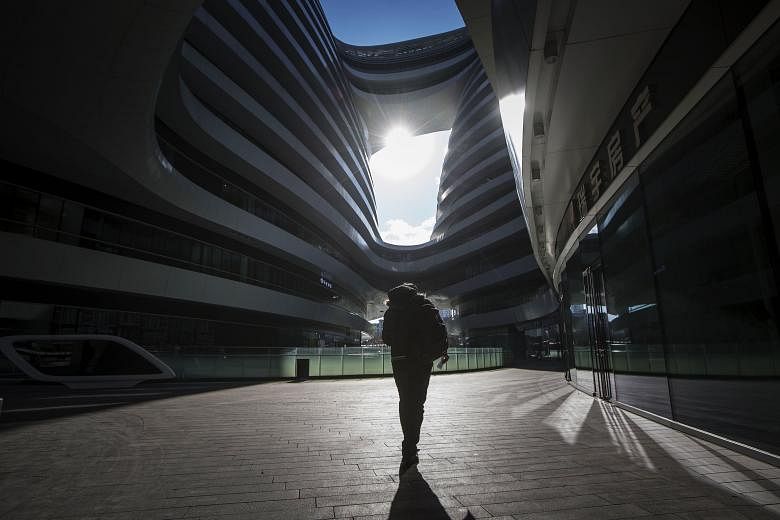They say you can't teach an old dog new tricks, but that's exactly what Asia and its investors need to do to withstand volatility and strike growth next year.
China's days of blistering growth are long gone. The world's second- largest economy registered 6.9 per cent gross domestic product (GDP) growth this year, the slowest in a decade, and we foresee it decelerating further to 5.5 per cent to 6 per cent by 2020. The industries erected to fuel China's development binge have been burnt by its recent slowdown; global commodity markets in particular are suffering from tumbling Chinese demand.
CHINA'S TRANSITION TO A NEW NORMAL
What we're seeing is a Chinese economy in transition: Since last year, consumption contributed more to GDP than investment, and services sliced off half of the country's total output growth. The composition of China's economic model is morphing from a reliance on fixed asset investment to consumption - slowing output and rising leverage should be expected next year.

This is a naturally occurring economic phenomenon. The bigger an economy becomes, the more difficult it is to maintain rapid growth. Thus, for China to become a middle-income, technologically advanced nation, its economy will need to evolve accordingly - precisely the Chinese government's intention. President Xi Jinping endorsed a more balanced, inclusive and sustainable growth model at China's Fifth Plenum by promoting services and high-tech innovation over exports and manufacturing.
This is positive news for those poised to facilitate China's transformation. But much of the region is not ready for this "new normal"; Asian portfolios and markets that still rely on China's old economy for growth should prepare for more pain in the years ahead. For Asia's investors and policymakers alike, the winners and losers of China's transition will be determined by their ability to shed old habits and transform alongside the region's economic epicentre.
ASIA'S INTERNET AND HIGH-GROWTH SERVICE SECTORS LIKELY TO BENEFIT
Emerging sectors in innovative manufacturing and services will not only prevail, but they will also flourish under this new economic order. Rising income growth and supportive government policy will help new economy sectors achieve growth rates of 20 per cent to
50 per cent next year, a multiple of what we project to be earnings growth of about 8 per cent for the key Asia ex-Japan equity benchmark.
Opportunities will be especially abundant within Asia's booming Internet industry, which is at an inflection point as its online population now holds a global majority and monetisation gathers steam. E-commerce will continue its reign as the dominant Internet trend, while nascent value-added services like digital advertising, e-payments and online gaming are also set to grease this transformation. Asia's Internet revenue growth should sustain at 20 per cent to 25 per cent next year and beyond, and China's Internet giants stand to benefit the most amid industry consolidation and improving margins for mobile.
In addition to Internet industries, other high-growth consumer services ranging from healthcare and insurance to tourism are earmarked for high-performance next year. Notably, public healthcare spending across Asia will jump dramatically as Asia's ageing population strains existing infrastructure. For example, the Chinese government is targeting a healthcare sector worth nine trillion yuan (S$1.9 trillion) by 2020, a seven-fold rise from 2011. Meanwhile, medical tourism to countries in Asean should pick up swiftly in the next decade, and liberalised drug pricing and higher drug manufacturing standards are creating new opportunities.
Singapore is well positioned to lead the region's foray into this new normal marketplace, given its service-centric economy, mature digital infrastructure and status as a regional healthcare and tourism hub. Tactically, Singapore and China are our most preferred equity markets in Asia ex-Japan heading into 2016, in part due to our assessment that both markets are now trading at deep values.
RETHINK INVESTMENTS RELATED TO TRADITIONAL DRIVERS OF GROWTH
Asia's economic growth is expected to follow China's lead and slow to a near 15-year low of 5.8 per cent next year, down from 6 per cent this year. China's waning demand and industrial destocking will still impede growth across the region. Asia-Pacific currencies, including the Singapore dollar, are also expected to be burdened by a weak yuan and strong dollar - we expect the US dollar to Chinese yuan to hit 6.80 and the US dollar to Singapore dollar to rise to 1.45 over 12 months. Meanwhile, Asian credit returns will likely be tepid at 2 per cent to 3 per cent for next year, though we still find Chinese high yield property bonds attractive for buy-on-hold investors.
Net commodity exporters like Australia, Malaysia and Indonesia, where China is their dominant customer, will be hurt the most from the nation's economic shift. A supply glut in natural gas, crude oil and iron ore, a result of over investment in the mid to late 2000s, is not receding any time soon. A sharp moderation in thermal coal, liquefied natural gas and palm oil prices from depressed Chinese demand has badly affected the three countries' near-term prospects and terms of trade.
This bleak outlook is further aggravated by the normalisation of US Federal Reserve monetary policy; we expect the Fed to start tightening this month. We would still avoid Malaysian equities as well as Malaysian and Indonesian bonds, both of which are vulnerable to future US rate hikes. We are also underweight Thai equities due to the nation's weakening trade activity.
Real estate investors should tread lightly next year, much to the chagrin of Singaporeans who have long viewed this asset class as a stalwart investment destination. In Asia, UBS' Global Real Estate Bubble Index ranked Singapore as overvalued, while Hong Kong alongside London is in outright bubble risk territory. In Singapore, housing oversupply and soggy demand has sent prices down 8 per cent from its 2013 peak. It could still fall another 7 per cent over the next 12 to 18 months, although this step down should put Singapore back into fair value territory.
In 2016, investors should prepare for heightened volatility especially in markets slow to embrace change. But for Asia's Internet and high-growth consumer service sectors, these will likely be key beneficiaries of the race to ride on China's wave of new economy wealth.
• The writer is Apac regional head, chief investment office, at UBS Wealth Management.

